AJKOER
Radically Dubious
    
Posts: 3026
Registered: 7-5-2011
Member Is Offline
Mood: No Mood
|
|
N2O, HOCl Route to Nitrate and some Chlorate
I have performed multiple runs of a new path to nitrate based on microwave treatment of an aqueous mixture of HOCl (preparation discussed below),
8.25% chlorine bleach (NaClO) and CaCl2, that was infused with N2O gas (source is an 8 gram of N2O pressurized gas cartridge designed for use in a
cream whipper which was employed here) and oxygen enriched air. A small amount of chlorate is also formed which can subsequently be greatly increased
via photolysis using the reported photocatalytic properties of the created nitrate. Actual portions employed in a particular run are detailed below
along with precautions and photos.
First, some theoretical background to provide understanding, promote safety and good yield.
One interesting paper is "Treatment of N2O impulsed microwave torch discharge " by M.Jasinski, et. al., April 2004 . To quote: "Results of using a
moderate–power (several hundred Watts) pulsed microwave torch plasma (MTP) to the conversion of atmospheric-pressure nitrous oxide (N2O) into
nitrogen oxides( NO, NO2 and N2O4) are presented." with a claimed efficiency between 70% to 90% depending on the power of the microwave. Link: https://www.google.com/url?sa=t&source=web&rct=j&...
This possible conversion of N2O is also cited in this source, "Focus on Hazardous Materials Research", edited by Leonora G. Mason, to quote : "In our
previous study using microwave discharge, N2O could be efficiently decomposed into N2 and O2 at atomospheric pressure [8]. However, when N2O is
diluted in N2/O2 mixtures was decomposed by microwave discharge, a large amount of NO was emitted due to fast reactions as N(2D,2P) + O2 --> NO +
O link: http://books.google.com/books?id=8MXX01Qw_G0C&pg=PA144&a...
So, for the purpose of constructing a net reaction for the gas phase in the radiolysis of N2O diluted in N2 and a O2 enriched mixture in a microwave,
I will assume, as an undoubted simplication, a reaction sequence that has one of the larger associated oxygen (which is supplied pre-run) and nitrogen
demands:
1/2 N2 + pulse radiation ---> N(2D,2P)
N(2D,2P) + O2 --> NO + O
O + N2O ---> 2 NO
Simplied net reaction ignoring possible benefical formation of any NO2 and several other intermediate nitrogen and oxygen species:
1/2 N2 + O2 + N2O --pulse radiation--> 3 NO
With shaking of the pulsed radiated vessel, a reaction with Hypochlorous acid:
2 NO + 3 HOCl + H2O --> 3 HCl + 2 HNO3
where the scrubbing of the NO is best accomplished between a pH of 4 to 7, and not more alkaline (see "Oxidation of Nitric Oxide in Two Stage
Chemical Scrubbers Using DC Corona Discharge" available at https://www.google.com/url?sa=t&source=web&rct=j&...
Late into the microwave treatment of the HOCl infused with N2O, one would add a mixture of NaClO, CaCl2 and NaHCO3 to significantly raise pH (in
essence, shifting from Nitrous oxide scrubbing to hydroxyl radical formation to induce chlorate creation):
2 NO + 3 HOCl + H2O + 10 NaClO + 5 CaCl2 + 9 NaHCO3 --> 13 NaCl + 2 NaNO3 + 5 CaCO3 + 10 HOCl + 4 NaHCO3
For a net reaction so far for the gaseous phase with N2O of:
1/3 N2 + 2/3 O2 + 2/3 N2O + 3 HOCl + H2O + 10 NaClO + 5 CaCl2 + 9 NaHCO3 --radiation--> 13 NaCl + 2 NaNO3 + 5 CaCO3 + 10 HOCl + 4 NaHCO3
Or, upon rescaling the net reaction:
N2 + 2 O2 + 2 N2O + 9 HOCl + 3 H2O + 30 NaClO + 15 CaCl2 + 18 NaHCO3 --radiation--> 39 NaCl + 6 NaNO3 + 15 CaCO3 + 30 HOCl + 12 NaHCO3
Next, apparently N2O in an aqueous setting has somewhat different chemistry on irradiation. Per this source, "Chemistry of Ozone in Water and
Wastewater Treatment: From Basic Principles to Applications", on page 229, the author Clemens Sonntag cites the following reaction involving a
solvated electron (actually, rescaled by 4, link: http://books.google.com/books?id=Om_TKidEjToC&pg=PA229&a... ):
4 e-(aq) + 4 N2O + 4 H2O ---> 4 ·OH + 4 N2 + 4 OH-
where there is no nitrate formation, and one source notes at elevated pH an associated increase in hydroxl radical activity (and potentially, chlorate
formation, please see https://www.google.com/url?sa=t&source=web&rct=j&... , hence the prior neutralization step).
Based on research, my take on the complex reaction (detailed below) between the hydroxyl radical and Hypochlorous acid giving some recognition to
possible multiple paths for the newly created ClO dimer (also called dichorine dioxide or chorine peroxide with a molecular formula of ClOOCl):
4 ·OH + 5 HOCl --> 4 H2O + 2 Cl2 + O2 + HClO3
And, on reacting with the available NaHCO3 added previously along with NaOCl and CaCl2 to shift pH higher:
NaHCO3 + HClO3 --> H2O + CO2 + NaClO3
2 Cl2 + 2 H2O = 2 HCl + 2 HOCl
NaHCO3 + HCl --> H2O + CO2 + NaCl
HCl + NaClO --> HOCl + NaCl
2 CO2 + 2 H2O + 4 NaOCl + 2 CaCl2 --> 4 NaCl + 2 CaCO3(s) + 4 HOCl
Implying a net reaction for irradiated dissolved N2O in water and Hypochlorous acid as follows:
4 e-(aq) + 4 N2O + 5 HOCl + 5 NaOCl + 2 CaCl2 + 2 H2O + 2 NaHCO3 --radiation--> 7 HOCl + 4 N2 + O2 + NaClO3 + 6 NaCl + 4 OH- + 2 CaCO3
Combining with the above gas phase created nitrate's net reaction:
2 N2 + 4 O2 + 4 N2O + 18 HOCl + 6 H2O + 60 NaClO + 30 CaCl2 + 30 NaHCO3 --pulse radiation--> 78 NaCl + 12 NaNO3 + 30 CaCO3 + 60 HOCl
One has the following estimate of the total reaction via microwave irradiation of a N2, O2, H2O, N2O, HOCl, CaCO3 and NaHCO3 mix, where I will assumed
equal weight for the gas phase relative to the aqueous phase reaction (subject to revision):
2 N2 + 4 O2 + 8 N2O + 23 HOCl + 8 H2O + 65 NaClO + 32 CaCl2 + 32 NaHCO3 --radiation--> 4 N2 + O2 + NaClO3 + 4 OH- + 84 NaCl + 12 NaNO3 + 32
CaCO3 + 67 HOCl
Or, per mole of N2O:
1/4 N2 + 1/2 O2 + N2O + 23/8 HOCl + H2O + 65/8 NaClO + 4 CaCl2 + 4 NaHCO3 --IR--> 1/2 N2 + 1/8 O2 + 1/8 NaClO3 + 1/2 OH- + 21/4 NaCl + 3/2 NaNO3
+ 4 CaCO3 + 67/8 HOCl
The nitrate can be isolated, as KNO3, by adding KCl and freezing. Alternatively, the excess of HOCl and presence of nitrate suggest a photolysis
exercise to increase chlorate production, which is detailed below.
--------------
A comment on the mixture of NaClO, CaCl2 and NaHCO3, the reaction mechanism is:
CaCl2 + 2 NaClO = Ca(ClO)2 + 2 NaCl
which further, in the presence of any added CO2 ( from, say, the action of a acid on NaHCO3), a bright white precipitate of CaCO3 is formed along with
Hypochlorous acid (which is recommended preparation for HOCl in the current synthesis) moving the above reaction to the right:
Ca(ClO)2 + CO2 + H2O ---> CaCO3(s) + 2 HOCl
Caution: if one creates HOCl from say, the action of vinegar on NaOCl, the Hypochlorous acid will contain sodium acetate. Unfortunately, the hydroxyl
radical being non-specific also attacks the acetate destroying the ·OH and introducing the smell of a volatile organic, which is potentially
poisonous and explosive in sufficient concentration mixed with the N2O in the microwave. An even more obnoxious compound is formed in the presence
citrate, so be mindful in avoiding the introduction of unwanted organics.
Also note, for each mole of HCl, HClO3 and HNO3 created, an equivalent mole of CO2 is formed and converted into CaCO3 (from CaCl2 + NaClO + CO2). The
insoluble Calcium carbonate can serve as a marker as it is easily separated at the end of the experiment and can be titrated against vinegar to get
an indication of expected maximum total yield of nitrate and chlorate.
-----------------------
Optional Photolysis in the Presence of Nitrate/Nitrite
Now, having created a small amount of nitrate and 1/12 of that amount in chlorate, this source, "Natural Processes and Systems for Hazardous Waste
Treatment" , edited by Say Kee Ong, page 128, (link: http://books.google.com/books?id=vPTmkWfDJk8C&pg=PA128&a... ) notes that the photolysis of nitrates and nitrites can lead to the formation of
hydroxyl radicals. The net reaction in the presence of NaNO3 and uv, I would express with convenient scaling for arriving at a net reaction as
follows:
4 NaNO3 + 4 H2O --hv--> 4 NO2 + 4 ·OH + 4 NaOH
With shaking, the hydrolysis of the NO2:
4 NO2 + 2 H2O --> 2 HNO2 + 2 HNO3
and, with further addition of HOCl:
2 HOCl + 2 HNO2 --> 2 HCl + 2 HNO3
Also:
4 NaOH + 4 HNO3 = 4 NaNO3 + 4 H2O
implying a net reaction for the photolysis reaction in the presence of nitrates/nitrites of:
2 HOCl +2 H2O ---uv, 4NaNO3---> 4 ·OH + 2 HCl
-----------------------------------
Memo: The usual photolysis path most likely proceeds along the following paths involving the species ·Cl, ·OH and ·ClO, which I have presented in a
prior thread and are scaled to faciliate the calculation of a tentative net reaction as a guide to the stoichiometrics:
2 Cl2 + hv --> 4 ·Cl
4 ·Cl + 4 HOCl --> 4 ·OH + 4 Cl2
4 ·OH + 4 HOCl --> 4 H2O + 4 ·ClO
which forms, at most, one Cl2O2 due to multiple paths:
2 ·ClO --> Cl2 + O2 (see, for example, http://ntrs.nasa.gov/search.jsp?R=19760050504 and Table I at https://www.google.com/url?sa=t&source=web&rct=j&... and also eq 13, page 204 at http://books.google.com/books?id=5YrqQqW11aYC&pg=RA1-PA2... )
2 ·ClO --> Cl2O2 (reference: see Table I in reference above and also http://discovery.ucl.ac.uk/1314688/ )
Finally, the creation of a chlorate:
Cl2O2 + HOCl --> HClO3 + Cl2 (Source: see equation R4 on page 6 at http://www.researchgate.net/publication/23141635_Effect_of_c... )
------------------
So, the implied net reaction per the above radical species route would be (starting with the 3rd equation as the hydroxyl radicals can be introduced,
in the current context, either by radiolysis or in a photolysis setting):
4 ·OH + 5 HOCl --> 4 H2O + 2 Cl2 + O2 + HClO3
Combined with: 2 HOCl +2 H2O ---uv, 4NaNO3---> 4·OH + 2 HCl per above, implies a net reaction of:
7 HOCl ---uv, 4NaNO3---> 2 H2O + 2 HCl + 2 Cl2 + O2 + HClO3
Or, upon adding just NaHCO3 or, a mixture of NaOCl, CaCl2 and NaHCO3, where elevated pH has been reported as increasing hydroxl radical activity, as
noted sbove:
7 HOCl + 7 NaOCl + 2 CaCl2 + 2 NaHCO3 ---uv, 4NaNO3---> 9 HOCl + 8 NaCl + O2 + NaClO3 + 2 CaCO3
where there is an additional generation of HOCl to reduce Hypochlorous demand or simply serve in providing an excess of HOCl.
Another reference, see Table 2, page 797 at http://www.geosci-model-dev-discuss.net/3/769/2010/gmdd-3-76...
Future research, microwave a mixture of CO2 and N2O, in the presence of water and a substance providing an electric discharge, in a fashion similar to
US Patent 5,266,175, link http://www.google.com/patents/US5266175, where a mix of CH4 and CO2 in a microwave has been patented by Exxon as a path to syngas (CO + H2), see
also discussion at http://www.wvcoal.com/research-development/spain-co2-ch4-hyd... . I have previously reported on SM sparking in the microwave reaction between N2O
and NaOH (see , http://www.sciencemadness.org/talk/viewthread.php?tid=32334 ) and more recently, to a limited extent, I witnessed it between aqueous NaHCO3 and
N2O. Now, as the action of uv light on CO2 has been reported to produce Singlet oxygen (to quote a source "We present a first principles study of the
carbon dioxide (CO2) photo dissociation process in the 150-to 210-nm wavelength range, with emphasis on photolysis below the carbon monoxide + O(1D)
singlet channel threshold at∼167nm.", link: https://www.google.com/url?sa=t&source=web&rct=j&... ), I suspect it may be one of the caustive agent in the patented microwave
synthesis. In the current context, the reaction of Singlet oxygen and N2O is known to form NO especially on cooling (see http://scitation.aip.org/content/aip/journal/jcp/78/2/10.106... ).
----------------------------
Sample Run Procedure (picture below of results from half of reaction, with the other half in a photolysis run):
1. Combine 154 ml of 5% vinegar and 11 g (around 5 ml) of NaHCO3 to form CO2 gas in a 3 liter vessel. Drain fluid leaving just CO2 gas.
2. Combine 209 ml of 8.25% NaOCl with 13.1 g (around 6.2 ml) of CaCl2 in a new vessel. Stir.
3. Add (2) to (1) and shake forming a bright white suspension of CaCO3. Cool to allow CaCO3 to settle, and pour out just the clear HOCl.
4. Infused the HOCl in (3) with an 8 g cartridge of N2O in a cream whipper. Shake to aid in the N2O infusion, which is limited in water.
5. In a 3 liter vessel (I used a 3 liter Poland Spring clear plastic water bottle that can standup in a microwave oven) react 28.7 ml of 3% H2O2 with
20.3 ml of 8.25% NaOCl. Drain all of the liquid leaving air enriched with O2 gas. Compress the vessel by 1/3 to allow for thermal expansion.
6. Place about HALF the contents of the infused HOCl from Step (4) into the enriched oxygen vessel of Step (5).
7. Radiate the vessel in a microwave for between 4 to 7 seconds only until the vessel is fully inflated. Remove the vessel, shake and cool by
inserting into an ice water bath as needed to implode the vessel. Caution: Do not attempt to microwave the fully expanded vessel since if the N2O
undergoes a thermal decomposition (sounds like a loud knock and the vessel acts if it was struck), the sudden rapid increase in volume from 2 N2O
---> 2 N2 + O2, coud cause a pressure eruption of the vessel.
8. Repeat Step (7) ten times or until shaking the vessel after a microwave treatment produces little compression. At this point, open the vessel in a
fumehood and manually compress by one third. Then, add 589 ml of 8.25% NaOCl, 8.2 g CaCl2 (around 17.25 ml), 6.3 g of NaHCO3 (around 13.8 ml), and the
rest of the N2O infused HOCl from the whipper.
9. Repeat Step (8) seven more times. End of nitration exercise. If not continuing with photolysis to enhance chlorate formation, add KCl and cool
overnight to recover KNO3 and any formed KClO3.
Optional Photolysis
1. On half of the contents only of Step (9), add 306 cc NaOCl, 3.3 g of CaCl2 (around 7 ml), 1.1 grams of NaHCO3 (around .5 ml) to the mixture in
Step (9), reseal and place in sunlight surrounded by reflective Aluminum for 6 hours in Day 1.
2. Place in freezer overnight (to limit HOCl decomposition) and continue photolysis for Day 2.
3. Add KCl and cool overnight to recover KNO3 and any formed KClO3. Reduction of volume of fluid by neutralizing with H2O2 (outdoors) and boiling as
needed.
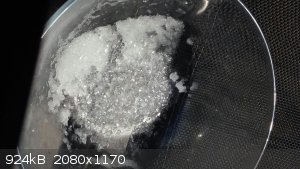
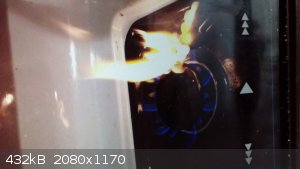
[Edited on 21-9-2014 by AJKOER]
[Edited on 21-9-2014 by AJKOER]
|
|
|
Metacelsus
International Hazard
    
Posts: 2543
Registered: 26-12-2012
Location: Boston, MA
Member Is Offline
Mood: Double, double, toil and trouble
|
|
How much nitrate does this actually produce?
|
|
|
AJKOER
Radically Dubious
    
Posts: 3026
Registered: 7-5-2011
Member Is Offline
Mood: No Mood
|
|
The product is mixed KNO3 and KClO3, is still damp and is about 8 ml in total volume, so around 16 grams. It represents half of the total yield as the
remainder is still undergoing photolysis.
As 8 grams of N2O was employed, divided by two is 4 g of N2O equivalvent to .09 moles. The expected combined moles of KClO3 and KNO3 pre-photolysis
is, per my calculations above, 13/8 moles per mole of N2O, or .14625 moles in total. As the molecular weight of KClO3 is 122.55 and 101.32 for KNO3,
even if pure KNO3, I would have expected at least 14.8 g. Using the expected relativity between KClO3 and KNO3, I would expect 15.1 g in total of
which 13.6 g should be KNO3. So far, the yield looks pretty good.
As a side note of the photolysis, I stopped after 2 days on 1/2 of the photolysis sample, which represents 1/4 of the total run. Already the amount of
precipitate of KNO3 and KClO3 for this quarter sample appears to exceed the return on half of the sample run that produced 16 grams.
[Edited on 21-9-2014 by AJKOER]
|
|
|
Metacelsus
International Hazard
    
Posts: 2543
Registered: 26-12-2012
Location: Boston, MA
Member Is Offline
Mood: Double, double, toil and trouble
|
|
You should do a selective, quantitative determination of nitrate. What you think is mostly nitrate could be something entirely different (chloride,
chlorate, etc.).
Only after you conclusively prove that you have nitrate will I be convinced that your method works (no matter how many references you have).
[Edited on 21-9-2014 by Cheddite Cheese]
|
|
|
AJKOER
Radically Dubious
    
Posts: 3026
Registered: 7-5-2011
Member Is Offline
Mood: No Mood
|
|
Yes, what you say is true, but in the ultimate test, ignition, that I happen to performed on a sample from a previous run, chloride does not
contribute and, given the significant dilution (water) present, I know it is not a soluble chloride. In fact, I suspect I am leaving some KNO3 in
solution as I did not concentrate it down.
I also have purchased KNO3 and proceeded to perform an ignition test with an equivalent amount of pure KNO3. It was not as vigorous as my sample that,
pre-photolysis, is supposed to have only a touch of chlorate (see second picture in opening thread).
As it is my intent to keep feeding the photolysis to magnified the total return of KClO3, the amount of KNO3, which serves as a photo catalyst, is not
really that important to me, especially as it appears to be in line with my expectation.
I should mention, it is possible that some KNO2, and not pure KNO3, could be produced with insufficient HOCl (or, upon employing too much N2O).
Fortunately, both the nitrite and nitrate apparently act in the capacity of a photo catalyst for chlorate formation.
[Edited on 21-9-2014 by AJKOER]
|
|
|
AJKOER
Radically Dubious
    
Posts: 3026
Registered: 7-5-2011
Member Is Offline
Mood: No Mood
|
|
OK, got some results on my photolysis of one quarter of a total run. An estimate of the the damp product is very close to 5 ml. This would imply, if I
have performed a total run with photolysis, I would have approximately 40 g of product.
I am starting with 8 g of N2O, equal to .18 moles. The calculations above estimate that without photolysis, I should expect, per mole of N2O employed,
1/8 NaClO3 + 3/2 NaNO3 + 67/8 HOCl. The photolysis net equation above suggests that 1/7 of the starting HOCl forms 1 mole of chlorate. So, I should
see .18*( 3/2*NaNO3 + (1/8+67/56)*NaClO3) of product.
This amounts to 56.5 g as compared with a 40 g estimated production, which equals to 71% of the ultimate projected photolysis result per my
calculations. As I have a two day total of sunlight of only around 10 hours, this yield is probably in line with uv exposure level.
I have attached a photo of the quarter run results.
[Edited on 21-9-2014 by AJKOER]
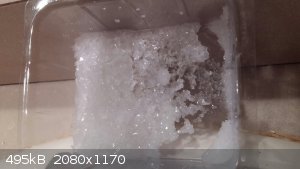
|
|
|
Oxirane
Hazard to Self
 
Posts: 92
Registered: 19-9-2014
Member Is Offline
Mood: No Mood
|
|
Could you use calcium hypochlorite instead? And could you use 254nm germicidal UV lights as photolytic source?
[Edited on 21-9-2014 by Oxirane]
|
|
|
AJKOER
Radically Dubious
    
Posts: 3026
Registered: 7-5-2011
Member Is Offline
Mood: No Mood
|
|
My first thought is that Ca(ClO)2 is more valuable than NaOCl, so try and find some cheap chlorine bleach first.
You also have the option of just adding Ca(ClO)2 to an aqueous solution of Na2CO3:
Ca(ClO)2 + Na2CO3 (aq) ---) 2 NaOCl (aq) + CaCO3 (s)
You can prepare Sodium carbonate by heating dry NaHCO3, Baking Soda, in a frying pan with stirring. As this is food grade, it may have less
impurities/additives than Na2CO3 sold as a laundry aid.
There are times when old chemistry texts cite the action of HOCl on a "neutral" chloride explicitly with respect to chlorate formation. I would not
consider Ca(ClO)2, Mg(ClO)2,...to be neutral chlorides in this context, so please neutralize per above.
[Edit] Cloudly overcast day, no on going photolysis attempted. Mixture kept frozen.
[Edited on 21-9-2014 by AJKOER]
|
|
|
AJKOER
Radically Dubious
    
Posts: 3026
Registered: 7-5-2011
Member Is Offline
Mood: No Mood
|
|
Quote: Originally posted by AJKOER  | ........
Future research, microwave a mixture of CO2 and N2O, in the presence of water and a substance providing an electric discharge, in a fashion similar to
US Patent 5,266,175, link http://www.google.com/patents/US5266175, where a mix of CH4 and CO2 in a microwave has been patented by Exxon as a path to syngas (CO + H2), see
also discussion at http://www.wvcoal.com/research-development/spain-co2-ch4-hyd... . I have previously reported on SM sparking in the microwave reaction between N2O
and NaOH (see , http://www.sciencemadness.org/talk/viewthread.php?tid=32334 ) and more recently, to a limited extent, I witnessed it between aqueous NaHCO3 and
N2O. Now, as the action of uv light on CO2 has been reported to produce Singlet oxygen (to quote a source "We present a first principles study of the
carbon dioxide (CO2) photo dissociation process in the 150-to 210-nm wavelength range, with emphasis on photolysis below the carbon monoxide + O(1D)
singlet channel threshold at∼167nm.", link: https://www.google.com/url?sa=t&source=web&rct=j&... ), I suspect it may be one of the caustive agent in the patented microwave
synthesis. ..... |
OK, something unexpected happen in the following experiment with respect to future research alluded to above.
In a plastic bottle half compressed to allow for gas expansion, containing only air, water vapor as the bottle was rinsed out with tap water, I have
place a two inch roll of Al foil connnected to the mouth of the bottle and held in place by tighening the lip. In essence, I created an Aluminum
filament like in a light bulb.
Upon irradiated in the microwave, the bottle expanded but, due to the extent of my initial compression of the bottle, it was not fully expanded. As
such, I continued on, and witnessed an obvious large spark from the Al filament and then there was a loud knock, the bottle expanded further and
jumped up.
What is surprising is this is precisely what happens on heating N2O in a microwave until it decomposes via:
2 N2O ---> 2 N2 + O2
as I have performed on prior occasions while experimenting with Nitrous oxide.
So, subject to further testing, it may be that microwaving just air in the presence of an substance providing an electric discharge (Aluminum foil in
the current case) can form significant N2O, in an operational manner similar to that cited in the Exxon patent.
Caution: Those repeating this experiment should provide at least 50% compression of the reaction vessel when employing air to avoid a possible
pressure detonation. Safety equipment is, as usual, advised as well.
[Edit] Repeated the experiment and I noticed about a 2 ml of water in the vessel before starting. Again, just after a big spark, an apparent N2O
decomposition. On cooling, the vessel returns to its compressed size.
This suggests a possible future run in my nitrate/chlorate preparation, downsizing by half to allow for any possible rapid gas expansion, adding an Al
filament and without the addition of any N2O , to see if and how much nitrate can be formed. If only NO is formed, than absent N2O, I would expect no
hydroxyl radicals and no/limited chlorate formation.
[Edited on 22-9-2014 by AJKOER]
|
|
|
Oxirane
Hazard to Self
 
Posts: 92
Registered: 19-9-2014
Member Is Offline
Mood: No Mood
|
|
Quote: Originally posted by AJKOER  | | My first thought is that Ca(ClO)2 is more valuable than NaOCl, so try and find some cheap chlorine bleach first. |
Ca(ClO)2 is a lot cheaper since it's sold in powder form per canisters, while bleach is sold at 3-10% solution, prices per pure kg ranging over 10
times as high. Secondly, while the output is NaNO3, I am more interested in Ca(NO3)2 because it can be used for larger variety of purposes.
|
|
|
AJKOER
Radically Dubious
    
Posts: 3026
Registered: 7-5-2011
Member Is Offline
Mood: No Mood
|
|
Quote: Originally posted by Oxirane  | Quote: Originally posted by AJKOER  | | My first thought is that Ca(ClO)2 is more valuable than NaOCl, so try and find some cheap chlorine bleach first. |
Ca(ClO)2 is a lot cheaper since it's sold in powder form per canisters, while bleach is sold at 3-10% solution, prices per pure kg ranging over 10
times as high. Secondly, while the output is NaNO3, I am more interested in Ca(NO3)2 because it can be used for larger variety of purposes.
|
I would, per my prior comment, add Na2CO3 to the Ca(ClO)2, forming NaCl0 and eventually some KNO3 using KCl per my original outlined procedure
requiring N2O for a good yield. Turning KNO3 into Ca(NO3)2 is a two step process. Add aqueous MgSO4 to KNO3 and cool to largely extract the K2SO4
leaving Mg(NO3)2, which I have previously performed with some success. Final step, I would try (not sure if it will work) by first creating a fresh
suspension of Ca(OH)2 and then adding the acidic Magnesium nitrate in solution. The precipitate should be Mg(OH)2, leaving Ca(NO3)2. Or, for certain,
a three step procedure by converting the Mg(NO3)2 to NH4NO3 by adding ammonia and then following the classic commercial procedure per Wikipedia (link:
http://en.m.wikipedia.org/wiki/Ca(NO3)2 ):
"It can also be prepared from an aqueous solution of ammonium nitrate, and calcium hydroxide:
2 NH4NO3 + Ca(OH)2 → Ca(NO3)2 + 2 NH4OH"
[Edited on 23-9-2014 by AJKOER]
|
|
|
AJKOER
Radically Dubious
    
Posts: 3026
Registered: 7-5-2011
Member Is Offline
Mood: No Mood
|
|
OK, got some results on running my original synthesis without N2O, in half size mode. I did, however, add an Aluminum filament which worked for the
1st half of the procedure only (fell into the solution during the addition of NaClO, CaCl2, NaHCO3 mix) and change the total O2 to N2 ratio as 1:1.
Per my prior comments on yield when I divided the full run in half to allow a photolysis treatment, I would have expected damp salt in the volume of
again 8 ml, but I got around 3.5 ml or so in this run absence N2O. So yield has apparently dropped by at least half in total, and perhaps much more so
for KNO3 formation without a precise test for nitrate/nitrite in the presence of chlorate (there could be little to no nitrate).
Visually per picture attached, I suspect much less KNO3 relative to KClO3 based on color and crystal structure. This picture should be comparative to
(but apparently not) the first picture in the opening thread. Also, here is an online picture of pure damp KClO3 for comparison purposes: https://www.google.com/?gws_rd=ssl#q=what+does+KClO3+look+li...
The most KNO3 that could be formed from 1.5 liter of N2 is 3/22.4 = .134 moles or 13.6 grams, so if any nitrate is being formed in the observed
product, this is a low efficiency path absence the use of N2O.
Or, one could view this experiment as verifying the role that N2O plays in my proposed synthesis.
I should also stress that my opening thread suggested preparation of Hypochlorous acid was to cool the HOCl to separate out the CaCO3. I used a
freezer and the HOCl was very cold, which is a potentially important point relating to the potential active role of Singlet oxygen (derived from HOCl
and hypochlorite), as it does react with N2O forming NO. Apparently Singlet oxygen formation proceeds inversely with temperature, meaning that the
temperature inversion (cold) increases formation of Singlet oxygen. Also, in the oxygen enrichment step via H2O2 and NaOCl, it should be performed
just prior to running the microwave treatment, as any formed Singlet oxygen in this reaction would be still around given its short life span.
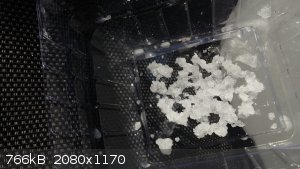
[Edited on 24-9-2014 by AJKOER]
|
|
|
AJKOER
Radically Dubious
    
Posts: 3026
Registered: 7-5-2011
Member Is Offline
Mood: No Mood
|
|
Another photolysis dump of half the remaining solution of 1,480 cc ( I added back the solution from the prior photolysis run, which was rich in HOCl,
and have added five times, while undergoing uv, a mixture of 153 cc NaOCl + 7 grams of CaCl2 + .25 g of NaHCO3, when the solution appears to be
getting clear, which is most likely from an excess of formed acid dissolving the suspension of CaCO3).
My calculated expectation based on chlorate only is: .5x1480x122.35/902.38/7 = 14.4 grams.
I was able to collect 7.5 cc of the damp salt, or around 15 g. See first picture (looks like pure KClO3).
The 2nd photo is a snapshot of the ignition of a small sample from the prior photolysis run.
-----------------------
The forecast is for rain and clouds for two days, after which, I will do a final photolysis run for 2 days of sun and report on the final extract,
again recycling the HOCl from the current run (stored in the freezer). Note, I could probably keep this going, but decided I have enough of the salt.
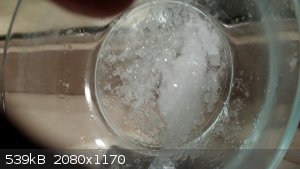 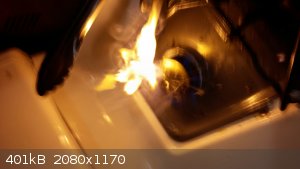
[Edited on 25-9-2014 by AJKOER]
|
|
|
AJKOER
Radically Dubious
    
Posts: 3026
Registered: 7-5-2011
Member Is Offline
Mood: No Mood
|
|
Here is the results of the last run: 37 ml of damp product or around 74 grams in total. See picture.
My handle, Ajkoer, may be an anagram for Ajoker, but no laughing at these yields! A comparison to yields generated by boiling (see, for example, https://www.google.com/url?sa=t&source=web&rct=j&... ) suggest a nearly three fold improvement.
This run occurred over 3 days of sun exposure with each day starting with the addition of 153 cc NaOCl + 7 grams of CaCl2 + .25 g of NaHCO3. There was
also a one time addition of 5 grams of KNO3 to enhance the photolysis catalytic properties of nitrate in the formation of chlorate. Note, in all runs,
I did not boil down the final solution, just added KCl and placed in a freezer overnight.
Those performing this experiment should comply with local laws and do not attempt to sensitize the KClO3, as there is undoubtly, a long list of
associated injuries (or worst). Here is a link to its MSDS https://www.google.com/url?sa=t&source=web&rct=j&...
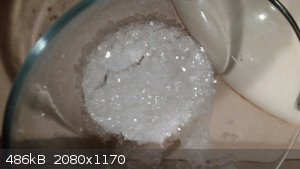
[Edited on 29-9-2014 by AJKOER]
|
|
|
blogfast25
International Hazard
    
Posts: 10562
Registered: 3-2-2008
Location: Neverland
Member Is Offline
Mood: No Mood
|
|
A comment on the mixture of NaClO, CaCl2 and NaHCO3, the reaction mechanism is:
| Quote: | CaCl2 + 2 NaClO = Ca(ClO)2 + 2 NaCl
which further, in the presence of any added CO2 ( from, say, the action of a acid on NaHCO3), a bright white precipitate of CaCO3 is formed along
with Hypochlorous acid (which is recommended preparation for HOCl in the current synthesis) moving the above reaction to the right:
Ca(ClO)2 + CO2 + H2O ---> CaCO3(s) + 2 HOCl |
As I've told you elsewhere the first equation does not represent an actual reaction: all species are soluble and all ions are spectators in that soup.
Why not simply use the very OTC Ca(ClO)2, directly in the second reaction, to form the HClO?
| Quote: | | My handle, Ajkoer, may be an anagram for Ajoker, but no laughing at these yields! |
So what are your actual percentage yields?
What is the right hand photo in your post of 06:32 (29-5-14)?
Have you got an overall stoichiometric equation for this process?
| Quote: | | I should also stress that my opening thread suggested preparation of Hypochlorous acid was to cool the HOCl to separate out the CaCO3
|
CaCO3 is highly insoluble at RT. Nothing gained by further cooling.
[Edited on 29-9-2014 by blogfast25]
|
|
|
AJKOER
Radically Dubious
    
Posts: 3026
Registered: 7-5-2011
Member Is Offline
Mood: No Mood
|
|
Some further comments on the mixture of NaClO, CaCl2 and NaHCO3. The reaction, for those who have performed it, is hard to described as, at first, the
entire solution is consumed by a slightly off white suspension (Ca(ClO)2), I suspect, but this itself is subject to hydrolysis). In minutes, the
solution is divided into two parts, one with an off-white suspension and the other, a clear green solution. So there is possibly an equilbrium with
CaCl2 and NaClO. However, per the reaction below, one could argue that it is limited, at least at RT, moving more to the right:
CaCl2 + 2 NaClO = Ca(ClO)2 + 2 NaCl
Now, when a acid (HCl, HClO3,..) is formed, the dissolved NaHCO3 can release CO2. The latter, especially on shaking of the solution, quickly appears
to produce a bright white precipitate of CaCO3 (along with Hypochlorous acid) moving the above reaction clearly to the right:
Ca(ClO)2 + CO2 + H2O ---> CaCO3(s) + 2 HOCl
So, when an acid is formed, HOCl is also created in situ along with a suspension of fine bright white CaCO3. The latter will settle out of the
solution on standing or more rapidly with cooling.
-------------------------------------
For a photolysis in the presence of nitrate/nitrite, I have described the reaction as:
7 HOCl + 7 NaOCl + 2 CaCl2 + 2 NaHCO3 ---uv, 4NaNO3---> 9 HOCl + 8 NaCl + O2 + NaClO3 + 2 CaCO3
However, upon restocking the solution for subsequent photolysis episodes with, 7 NaOCl + 2 CaCl2 + 2 NaHCO3, all the Hypochlorous acid can be
consumed. I verified this reaction to completion by adding H2O2 at the final conclusion of this experiment which displayed no significant oxygen
formation.
--------------------------------------
My relative approximate yield calculation is simple by assuming all of the final solution size of 2.2 liters was sourced by 8.25% NaClO. The alluded
to boiling method claims 9 grams of KClO3 from 500 ml of also 8.25% bleach, or upon rescaling to my solution size, this would be 39.6 grams of
product. My total experiment yielded 115 g. The ratio is 2.9.
[Edited on 30-9-2014 by AJKOER]
|
|
|
blogfast25
International Hazard
    
Posts: 10562
Registered: 3-2-2008
Location: Neverland
Member Is Offline
Mood: No Mood
|
|
Quote: Originally posted by AJKOER  |
Now, when a acid (HCl, HClO3,..) is formed, the dissolved NaHCO3 can release CO2. The latter, especially on shaking of the solution, quickly appears
to produce a bright white precipitate of CaCO3 (along with Hypochlorous acid) moving the above reaction clearly to the right:
Ca(ClO)2 + CO2 + H2O ---> CaCO3(s) + 2 HOCl
|
The Wiki listed pKa of HClO is 7.53. In plainer English:
[H3O+][ClO-]/[HClO] = 10<sup>-7.53</sup> (3 x 10<sup>-8</sup>, barely over 1 billionth!). Imagine how much H3O+ that's gonna
generate!
HClO is an extremely weak acid, another 1000 times weaker than acetic acid for instance. It's a bit like expecting boric acid to react with Na2CO3: it
doesn't happen.
|
|
|
AJKOER
Radically Dubious
    
Posts: 3026
Registered: 7-5-2011
Member Is Offline
Mood: No Mood
|
|
Quote: Originally posted by blogfast25  | .....
The Wiki listed pKa of HClO is 7.53. In plainer English:
[H3O+][ClO-]/[HClO] = 10<sup>-7.53</sup> (3 x 10<sup>-8</sup>, barely over 1 billionth!). Imagine how much H3O+ that's gonna
generate!
HClO is an extremely weak acid, another 1000 times weaker than acetic acid for instance. It's a bit like expecting boric acid to react with Na2CO3: it
doesn't happen. |
While I agree with respect to your comments on the dissociation of HOCl, per the radical chemistry discussed in the opening thread, it is the
undissociated HOCl that reacts with the hydroxyl radical.
I have not discussed other side reactions like:
2 HOCl --uv--) 2 HCl + O2
that lead to a loss of HOCl. However, anytime HCl (and also, HClO3 per the radical pathway discussed in the opening thread), is formed from HOCl, the
consumed HOCl can be replaced. The mechanics occurrs via NaHCO3 (not Na2CO3 as you cited), which reacts with acids (HCl, HClO3,..) restoring HOCl via
the CO2 path (assuming available NaOCl and CaCl2) discussed previously. This is, in essence, also a pH managment tool.
[Edited on 30-9-2014 by AJKOER]
|
|
|
blogfast25
International Hazard
    
Posts: 10562
Registered: 3-2-2008
Location: Neverland
Member Is Offline
Mood: No Mood
|
|
Sigh.
My comment re. the pKa of HClO was specifically in response to:
Quote: Originally posted by AJKOER  |
Now, when a acid (HCl, HClO3,..) is formed, the dissolved NaHCO3 can release CO2. The latter, especially on shaking of the solution, quickly appears
to produce a bright white precipitate of CaCO3 (along with Hypochlorous acid) moving the above reaction clearly to the right:
Ca(ClO)2 + CO2 + H2O ---> CaCO3(s) + 2 HOCl
|
The point remains that to prepare solutions of hypochloric acid, using calcium hypochlorite would be easier than your tortured reasoning:
Ca(ClO)2 + CO2 + H2O ---> CaCO3(s) + 2 HOCl
|
|
|
AJKOER
Radically Dubious
    
Posts: 3026
Registered: 7-5-2011
Member Is Offline
Mood: No Mood
|
|
Winter Photolysis Simplified Run
I have performed a simplified photolysis run taking advantage of some outside snow coverage that apparently can magnify uv exposure. For this run, I
used a nitrate source (KNO3, although per my readings, a nitrite source like NaNO2 may even perform better), NaHCO3 and HOCl (prepared as detailed in
the opening thread) with a touch of vinegar on the second day to added NaHCO3 to promote CO2 creation. An interesting point is that the thin clear
plastic vessel actually sat on a snow bank so the aqueous mixture was cold during the three day photolysis run, and otherwise stored at room
temperature.
With further research, I have come to suspect that I may not have properly credited a particularly important radical contributing to the current and
prior good yields (see details below on this run's yield results). In particular, citing source material in the following doctoral thesis, "Carbonate
Radical in Natural Waters" by Jiping Huang at the University of Toronto, link: https://www.google.com/url?sa=t&source=web&rct=j&... I extracted the following pertinent comments:
Per page 4, "Carbonate radicals can be generated by pulse radiolysis of aqueous solutions of carbonate or bicarbonate saturated with N2O (Weeks and
Rabani, 1966)", which is interestingly exactly how my opening thread suggests making the photocatalytic nitrate and apparently also, in the presence
of bicarbonate, the unheralded carbonate radical as well.
Per page 14, "The photooxidants include hydroxyl radical (Draper and Crosby, 1984), alkylperoxy radical (Mill et al., 1980), singlet oxygen (Haag and
Hoigne, 1986), triplet state (Zepp et al, 1985), &nitrate radical (Larson and Zepp. 1988), dibromide ion radical, (Zafhiou et al., l984), solvated
electrons (Zepp et al., 1987a) and superoxide (Petasne and Zika, 1987). Hydrogen peroxide, a widely distributed oxidant in natural waters that is
produced via the intermediacy of superoxide radicals (Cooper and Zika, l983), may be involved in the oxidation of these compounds by the Fenton
reaction (Zepp et al., 1992) or by peroxidase-catalyzed oxidation (Cooper and Zepp, 1990)."
where interestingly the listing of multiple possible photo-oxidants includes singlet oxygen who formation and life span is enhanced at low
temperatures.
Per page 15, " A variety of reaction pathways are available for the generation of hydroxyl radical in natural waters (Mabury and Crosby, 1994). The
major sources appear to be the photolysis of nitrate (Hagg and Hoigne, 1985, Zepp er al., 1987b), nitrite (Zafiou, 1974), hydrogen peroxide (Draper
and Crosby, 198 I), and dissolved organic carbon (DOC) (Mill et al., 1980). Production of hydroxyl by nonphotochemical pathways proceed via
Fenton-type reactions between reduced metals (Fe, Cu, Mn) and hydrogen peroxide"...Haag and Hoigne (1985) have suggested that nitrate could well be
the dominant precursor of photolytic production of hydroxyl radical in lake water. "
Per page 21, " However, a quenching effect (on the hydroxyl radical) by carbonate and a much smaller effect by bicarbonate was observed.."
And finally per page 22, perhaps the most important comment:
"Carbonate radicals lead to bromate and chlorate formation during drinking water treatment. ... During ozonation, carbonate radicals formed from
hydroxyl radical scavenging, oxidize the intermediate hypobromite to bromite, which is then further oxidized by ozone to bromate (Gunten et al., 1994;
1995). Carbonate radicals formed in alkaline waters act as secondary oxidants of bromine leading to the enhanced bromate formation (Ozekin et al.
1998). During ozonation of chlorine-containing waters, the presence of alkalinity also enhanced chlorate formation due to the secondary reactions
between carbonate radicals and chlorine species (Siddiqui et al., 1996). "
where in the current context of chlorate preparation, I would not be surprised if the carbonate radical expedites chlorite formation similarly (which
constitutes a slow rate determining step in the aqueous chlorate formation process) via the reaction:
NaOCl + HOCl → NaClO2 + HCl
as is apparently the case for bromite, followed by an aqueous chlorate formation path:
NaClO2 + HOCl → NaClO3 + HCl
With respect to the carbonate radical, a cited reaction leading to its formation includes:
HCO3- + •OH → CO3•(-) + H2O
But, this is also a quenching reaction removing the hydroxyl radicals that has a role in chlorate formation (see opening thread for reaction sequence
or Figure 3 provided in reference below).
Now, in my current preparation of chlorate, employing a nitrate together with uv, is the source for hydroxyl radical generation via an aqueous
photochemical reaction:
NO3- + hv → •NO2 + •OH (see http://pubs.acs.org/doi/abs/10.1021/ja073609 )
Also, NO2- + hv → NO + •OH (actually, more complex, see, for example, discussion on page 2 at
https://www.google.com/url?url=http://scholar.google.com/sch... )
And, in the presence of water and HOCl in a closed system, additional reactions:
2 NO2 + H2O → HNO2 + HNO3
HNO2 + HOCl→ HNO3 + HCl
which allows the nitrate to be reclaimed and generate more hydroxyl radicals, thus providing for the catalytic formation of hydroxyl radicals.
Also while the seeming focus has been on paths to chlorate formation, there are some (including myself) who do not mind incidental perchlorate
formation as well. Per this source "Perchlorate Formation by Ozone Oxidation of Aqueous Chlorine/Oxy-Chlorine Species: Role of ClxOy Radicals" by
Balaji Rao, et al., in Environ. Sci. Technol., 2010, Vol. 44, pages 2961–2967, to quote:
"Photochemical mediated oxidation of HOCl/OCl- and ClO2- but not Cl- or ClO3- also form ClO4-, with similar yields (13,14)"
meaning yields similar to powerful ozone oxidation. I also found Figure 3, on page 2966, very informative in noting reactions associated with gas
phase versus aqueous reactions ending in chlorate, and also the role of known stable radicals vs. intermediate species and postulated species. Link:
http://www.researchgate.net/publication/42607827_Perchlorate...
As a sidebar, while I commend the authors on their carefully crafted laboratory research work, I must admit I have a major issue in drawing any major
conclusions on the magnitude of chlorate formation in a different setting, natural waters, as my references, noted above, clearly cite many pathways,
including, for example, the carbonate radical, that could occur in natural waters, which could greatly expand chlorate levels. One can view my results
below as actually suggesting a possible significant augmentation of chlorate formation in the presence, for example, of bicarbonates, and so called
dissolved organic matter (which can promote hydroxyl radical formation with sunlight).
---------------------------------------------------------------------------------
On the actual experiment performed for this winter run, I first created 2.2 liters of CO2 by the action of 119 ml of 5% vinegar on 7.5 g (around 3.8
ml) of baking soda, NaHCO3. I added NaCl to further release dissolved carbon dioxide, followed by carefully draining, leaving CO2. To this gas, I
added a previously prepared mix of HOCl and CaCO3 as the product of reacting 82 ml of 8.25% chlorine bleach (NaOCl), and old CaCl2 (which I assumed
was now entirely CaO.CaCl2) per the reaction:
2 NaOCl + CaO.CaCl2 + 2 CO2 (g) + H2O --) 2 CaCO3 (s) + 2 HOCl + 2 NaCl
It quickly became evident (see 4th photo below) that I added an excess of CaCl2 (thereby increasing ionic strength and leaving unreacted CO2 and free
Cl2 to aid in a gas phase reaction forming possibly some ClxOy) as green chlorine coloration became apparent. (This, I now view, as possibly a
fortunate mistake as it may have furthered boosted the production of chlorate as I witness, in spite of the vessel placed on snow, condensation in the
vessel which may have benefited from gas phase chlorate formation reactions). I then added 5 ml of KNO3 (around 10 g), 164 ml of the 8.25% NaOCl and
after shaking in a closed 3 liter clear plastic vessel, I placed on a snow bank in bright sunlight. After a few hours, I added 5 ml (about 9.9 g) of
NaHCO3. At the start of the second day, I added 80 ml more of NaOCl. On the third day, fearing the loss of CO2, I added more 5 ml of NaHCO3 and 15 ml
of vinegar. During the nights, the vessel was kept at room temperature. Next day, absence the availability of strong sunlight, I placed the vessel in
a freezer letting a white undissolved salt to settle. This solution was decanted created a clear solution and I stored some 30 ml containing sediment.
To the clear solution an excess of KCl was added and left overnight in a freezer. Around 12 ml of damp (forming 23.0 g dry) of KClO3/KNO3 was
recovered (see 1st and 3rd pictures). As the solution continued to have a strong HOCl presence (which is expected), I added a large quantity of NaHCO3
and the prior 30 ml of left over stored sediment solution. Upon standing, I decanted off the clear part of solution, some 320 ml now, and left over
night in a freezer. The result was another 5 ml of damp now large flat square-like KClO3 crystals, (9.6 g dry, see the 2nd picture). So, I formed
around 22.6 g of KClO3 from 320 ml of NaOCl/HOCl. Previously in performing a relative yield comparison, I reported 115 g for 2.2 liters of NaOCl/HOCl,
which would imply an expectation for this run of just 16.7 g, which has apparently been exceeded (but I did not try to squeeze more out the solution
as I did here).
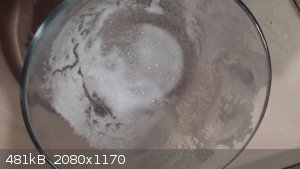
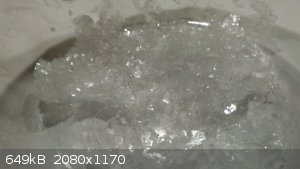
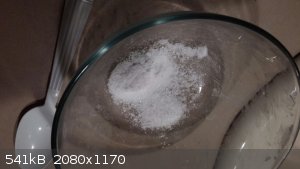
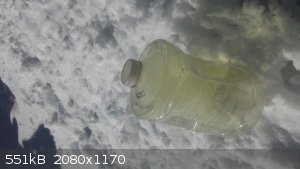
[Edited on 18-3-2015 by AJKOER]
|
|
|
Bezaleel
Hazard to Others
  
Posts: 444
Registered: 28-2-2009
Member Is Offline
Mood: transitional
|
|
For those interested in the article elaborating on NO3- + hv → •NO2 + •OH, use the following link, as the one above is incomplete.
|
|
|
AJKOER
Radically Dubious
    
Posts: 3026
Registered: 7-5-2011
Member Is Offline
Mood: No Mood
|
|
I have witness over time that many of my provided links are quite ephemeral. In the future, I will supply article titles so that when the links no
longer works, an updated web search may resurrect the material.
Thanks for the new link, as it also suggests a photolysis path to nitrite from nitrate, a topic discussed previously on SM. Here is a quote:
"Photolysis of aqueous NO3- with λ ≥ 195 nm is known to induce the formation of NO2- and O2 as the only stable products."
Source: "Mechanism of Nitrite Formation by Nitrate Photolysis in Aqueous Solutions: The Role of Peroxynitrite, Nitrogen Dioxide, and Hydroxyl
Radical", by Sara Goldstein and Joseph Rabani. Published in Journal of the American Chemical Society, Vol. 129: Issue. 34:, pages. 10597-10601,
publication Date (Web): August 4, 2007.
-----------------------------------------------------
My recent readings suggest (yet to be verified) that N2O infused into an aqueous suspension of select metal oxides (TiO2, ZnO, MgO, FeOOH, ...) in
solar light (as otherwise with N2O, microwave irradiation or UV light recommended) may be a supplemental path to hydroxyl radicals (that is, in
addition to those created by photo active metal oxide). My rough take on the chemistry:
ZnO + hv → e- + h+
And, focusing on the formation and interactions with solvated electrons:
e- + nH2O → e-(aq)
e-(aq) + N2O → N2 + •O-
•O- + H2O → •OH + OH-
Interestingly, so called Fe(lll) (hydr) oxides occur in natural waters (see http://www.sciencedirect.com/science/article/pii/03044203950... ).
--------------------------------------------------
Alternatively, in place of sunlight and photo sensitive metal oxides, worthy of testing could be employing a galvanic couple at near neutral to
alkaline pH. The chemistry would similarly follow with aqueous N2O. I should cite an additional reaction that occurs with H+ or H2O leading to the
reducing mono atomic hydrogen radical and H2 formation (more precisely, to quote Wikipedia at https://en.m.wikipedia.org/wiki/Galvanic_corrosion , "If the electrolyte contains only metal ions that are not easily reduced (such as Na+, Ca2+,
K+, Mg2+, or Zn2+), the cathode reaction is reduction of dissolved H+ to H2 or O2 to OH−", where the oxygen reaction occurs in more alkaline
conditions). My take:
H2O = H+ + OH-
e- + H+ → •H
•H + •H → H2
Here is an interesting account speaking to the consequences of a formed galvanic couple:
"It is claimed that the two metals composing the alloy, copper and zinc, forming a galvanic couple, set up a mild electrolytic action on the water
flowing with the pulp, whereby hydrogen is evolved. This, being in the nascent state, is exceedingly energetic in "reducing" those sulphides which
cause the sickening of mercury and consequent patches of verdigris on the plates."
Source: "Gold Milling: Principles and Practice", Charles George Warnford Lock, p. 236, link: https://books.google.com/books?pg=PA236&lpg=PA236&dq...
[Edited on 2-5-2017 by AJKOER]
|
|
|
AJKOER
Radically Dubious
    
Posts: 3026
Registered: 7-5-2011
Member Is Offline
Mood: No Mood
|
|
Some science updates: I have recently seen some claims of the reaction between oxygen and the •ClO radical on surfaces (see https://books.google.com/books?id=ZpxGDwAAQBAJ&pg=PT83&a... ):
•ClO + O2 + M > •ClO3 + M
Here is an abstract from a different source: 'Asymmetrical ClO3: its possible formation from ClO and O2 and its possible reactions', at https://www.sciencedirect.com/science/article/abs/pii/004726... , to quote from the abstract:
"An analysis of recent accurate experimental studies of Cl2-photosensitized O3 decomposition, in which O3 disappearance and OClO formation were
directly monitored, suggests the possibility that the suppression of the quantum yield in the presence of O2 may be due to the formation of
asymmetrical chlorine trioxide (ClO·O2). Other intermediaries, such as Cl2O2, which may also form in the system are not thought to explain the
observations. In addition to its capacity to oxidize, which it shares with other peroxo compounds, asymmetrical ClO3 appears to undergo an interesting
class of reactions in which the loosely bound O2 adduct is relatively easily displaced by reactive atoms and radicals such as chlorine."
Also, even if the reaction of O2 with the •ClO radical is slow, I relatedly suspect that the following reaction based on the superoxide radical
anion, •O2-, in place of oxygen is likely faster:
•ClO + •O2- -> ClO3-
where the superoxide may be formed in the presence of oxygen and transition metal oxides.
This chlorate radical may be important (in a different context than electrolysis) with perchlorate formation per my recent cited comment from an
article "Mechanism of Perchlorate Formation on Boron-Doped Diamond Film Anodes" per, Azizi et al, at https://pubmed.ncbi.nlm.nih.gov/22029642/ , to quote:
"Perchloric acid is then formed via the activationless homogeneous reaction between ClO(3)(•) and OH(•) in the diffuse layer next to the BDD
surface. DFT simulations also indicate that the reduction of ClO(3)(•) can occur at radical sites on the BDD surface to form ClO(3)(-) and ClO(2),
which limits the overall rate of ClO(4)(-) formation."
The possible reaction of interest being:
HO• + ClO3• -> HClO4
which would be involved in perchlorate creation.
[Edited on 3-4-2020 by AJKOER]
|
|
|
AJKOER
Radically Dubious
    
Posts: 3026
Registered: 7-5-2011
Member Is Offline
Mood: No Mood
|
|
Also, an extract from a recent perchlorate thread, that with respect to chemistry, implies a strong role for surface chemistry. Note, if one employs
a HOCl(aq)/CaCO3(s) mix (from the creation of hypochlorous from the addition of CO2 or NaHCO3 to a mix of NaOCl and CaCl2) the CaCO3 being a carbonate
is photoactive and also a good source of surface area for possible surface chemistry. To quote:
Quote: Originally posted by AJKOER  | OK, found a reference which is a game-changer (like when one could potentially get a 100% conversion of chloride to perchlorate) for those with access
to Boron doped diamond film electrodes (BDD). Apparently, great electrodes, but perhaps too good, as when applied to the electrolysis of hypochlorite,
they contributed to some major unwanted byproduct formations, not just chlorate but perchlorate as well.
Per " Understanding Chlorite, Chlorate and Perchlorate Formation When Generating Hypochlorite Using Boron Doped Diamond Film Electrodes available http://citeseerx.ist.psu.edu/viewdoc/download?doi=10.1.1.100... to quote:
"Oxychlorine radicals (ClO•, ClO2•, ClO3•) were found to chemically adsorb to both secondary and tertiary carbon atoms on the BDD surface. These
chemisorbed intermediates could react with hydroxyl radicals to regenerate the original chlorine oxyanion (ClO−, ClO2-, ClO3-), and produce ≡CO•
and =C•HO sites on the BDD surface. The ≡C-O• and =C•HO sites also reacted with oxychlorine radicals to form chemisorbed intermediates, which
could then be converted to higher oxidation states (ClO2, ClO3−, ClO4-) via reaction with hydroxyl radicals. "
And:
"Batch experiments show complete conversion of chloride to perchlorate can be achieved with prolonged electrolysis times. Perchlorate production can
be minimized in batch and flow-through systems by using low current densities, high mass transfer rates, and high concentrations of chloride (9, 11,
12). High mass transfer rates, driven by fluid convection, are hypothesized to affect the multistep reaction for perchlorate formation from chloride,
as chloride ions are progressively oxidized to higher oxychlorine anions, as illustrated by:
Cl− -> OCl− -> ClO2− -> ClO3− -> ClO4
High rates of mass transfer near the surface result in low concentrations of intermediate products, so that complete chloride oxidation to perchlorate
can be minimized. "
Cited reactions of interest include:
HOCl + HO• -> OCl• + H2O [2]
OCl• + HO• -> HClO2 [4]
HOCl2 + HO• -> ClO2• + H2O [13]
ClO2• + HO• -> HClO3 [15]
More on perchlorate formation:
"Production of perchlorate from chlorate has been presented previously in Azizi et al. (37). A brief summary of the most important reactions is
contained here. Figure 6 shows the generation of ClO3• and HO• near the BDD anode surface, which subsequently combine, activationlessly, to form
HClO4. Chlorate radical production occurs more readily than water oxidation, as it becomes activationless at 0.76 V/SHE. The combination of radicals
is activationless, with a reaction energy ΔE = −133 kJ/mol."
Comments from a prior work "Mechanism of Perchlorate Formation on Boron-Doped Diamond Film Anodes" per, Azizi et al, at https://pubmed.ncbi.nlm.nih.gov/22029642/ , to quote:
"Perchloric acid is then formed via the activationless homogeneous reaction between ClO(3)(•) and OH(•) in the diffuse layer next to the BDD
surface. DFT simulations also indicate that the reduction of ClO(3)(•) can occur at radical sites on the BDD surface to form ClO(3)(-) and ClO(2),
which limits the overall rate of ClO(4)(-) formation."
The above works suggest possible parallel investigations, not just in electrolysis experiments, but also in battery/electrochemical cells (for
example, the "Bleach Battery") with different carbon-based electrodes.
[Edited on 3-4-2020 by AJKOER] |
|
|
|
|